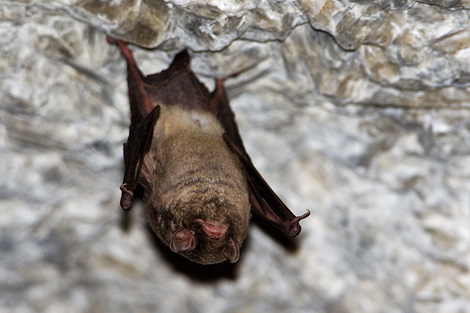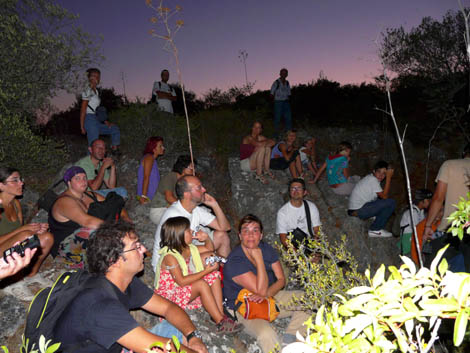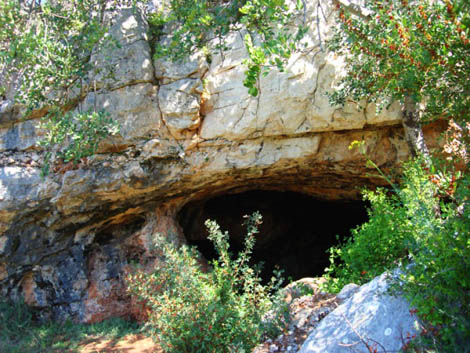 The Algarve has six underground shelters for cave bats classified as “of national importance”, but the bat population has been declining in the region, even in protected areas such as Rocha da Pena and Fonte da Benémola, denounced Almargem.
The Algarve has six underground shelters for cave bats classified as “of national importance”, but the bat population has been declining in the region, even in protected areas such as Rocha da Pena and Fonte da Benémola, denounced Almargem.
The Algarve environmental association regrets that its proposals for some of these natural shelters, with measures to prevent the continued decline of bats, have been ignored either by the Institute for the Conservation of Nature and Forests (ICNF) or by the Câmara de Loulé, county where there are important caves integrated in protected areas managed by the municipality.
The ICNF recently released a report on the 1988-2012 period of the National Importance Underground Shelter Monitoring Program for cave bats, ie those that live in caves or caves.
Among the 76 shelters considered across the country, bat populations suffered a decrease in 30% of these shelters and an increase in 20% of shelters. In the remaining 50%, the situation is stable (14%) or undetermined (36%).
Of the nine species considered in this report, three have globally stable populations, while one – the little rat bat (Myotis blythii) – is in sharp decline, while for the remaining five species the situation is undetermined.
The most relevant general conclusion to draw from this report is that in Portugal, in the last 25 years, there has been a decline in the population of cave bats in 30% of the shelters, certainly much more, considering the high number of situations yet to be determined, uncertainty that also exists with regard to the situation of most species.
The Almargem Association considers this last circumstance "truly unjustifiable", taking into account "the means used and the efforts developed by the ICNF over all these years, which would imply a more adequate monitoring of cave habitats and bat populations that there they find their main refuge».
The association emphasizes that all species in question are protected by national and European legislation, “which should oblige the Portuguese State to develop active conservation measures”.
Five shelters in the Algarve were disqualified

With regard to the Algarve, six shelters continue to be classified as “of national importance”, located in Alcoutim, Aljezur (2), Loulé (2) and Lagoa, while another five were demoted, either because they have not been visited recently or because their bat colonies have almost disappeared.
In only two of the shelters of national importance located in the Algarve, there was a significant improvement in the respective bat populations. This is the case of the Aljezur I shelter, with a consistent increase in the populations of the fringed bat (Myotis escaleirai) and the horseshoe bat (Rhinolophus mehelyi), and the Loulé I shelter, with an increase in the bat populations. teddy bat (Miniopterus schreibersii) and small rat bat (Myotis blythii).
For its part, the Loulé II shelter (Rocha da Pena) has been losing a large part of its troops, the same having happened at the Loulé III shelter (Fonte da Benémola), where the bat colonies have practically disappeared, which is why this shelter, one of the most important for 25 years, was disqualified.
Almargem notes the fact that, in the two caves located in the Local Protected Landscape Areas (APPL) of Rocha da Pena and Fonte Benémola, created largely due to the importance of the area for the bat fauna, the current situation is «very negative".
In Rocha da Pena, the entrance to the Algar dos Mouros cave is obstructed and at imminent risk of collapse and, «despite the appeals made over the last few years either by Almargem or other entities, neither the ICNF nor the Municipality Loulé (who has managed the APPL since 2008) have shown themselves capable of solving the problem».
Even more serious is the situation in the Salustreira caves, located in the APPL of Fonte Benémola (also managed by the Municipality of Loulé).
"In 25 years, the vast breeding colonies of teddy bat (Miniopterus schreibersii), small rat bat (Myotis blythii) and buckshoe bat (Rhinolophus mehelyi) have almost completely disappeared."
Therefore, if a good part of these colonies had not moved to the Loulé I shelter, «possibly today we would be in a situation of serious decline of the three species in the Algarve».
Almargem's proposals ignored by the Chamber of Loulé
 In 2010, Associação Almargem presented to the Municipality of Loulé a proposal to revise the APPL Regulations of Rocha da Pena and Fonte Benémola, which included the classification of Salustreira and Algar dos Mouros caves as “Integral Protection Zones”, preferably implying the acquisition and sealing of the land where these shelters are located.
In 2010, Associação Almargem presented to the Municipality of Loulé a proposal to revise the APPL Regulations of Rocha da Pena and Fonte Benémola, which included the classification of Salustreira and Algar dos Mouros caves as “Integral Protection Zones”, preferably implying the acquisition and sealing of the land where these shelters are located.
The objective, explains the association, was "to guarantee safety and create better conditions for a medium-term recovery of bat populations in these caves."
Regarding the Loulé I shelter, also located inside the Barrocal Site of the Natura 2000 Network but outside any local protected area, the Almargem Association recalls that «it has already made the ICNF and the Municipality of Loulé aware of the urgent need for an intervention that guarantees the lasting safeguard of this place, which is increasingly important for the survival of many species of cave bats in the Algarve».
“Unfortunately, in none of these cases, Almargem's proposals had any practical consequences”, regrets the association.
«Between the ICNF's passivity and the lack of interest of most of the municipalities involved, this is how the increasingly uncertain fate of the population of cave bats in Portugal and, in particular, in the Algarve, is defined, precisely at a time when a little across Europe, the situation of bat populations seems to show a slight improvement trend», concludes Almargem.


















Comments